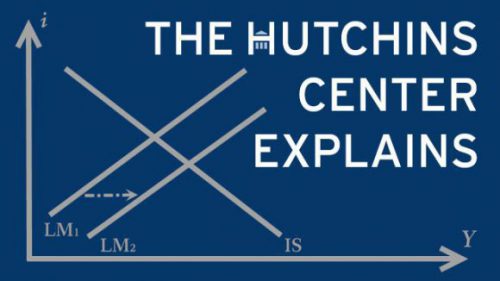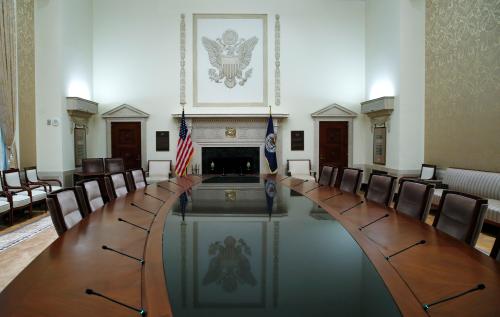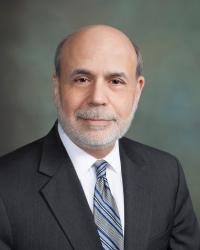In yesterday’s post, I discussed recent research, by Michael Kiley and John Roberts of the Federal Reserve Board, on the problems for monetary policy that arise from the fact that short-term interest rates can’t fall (much) below zero. [1] Using econometric models to simulate the performance of the U.S. economy, Kiley and Roberts (KR) find that, under certain assumptions, in the future short-term interest rates could be at zero as much as 30 to 40 percent of the time, hobbling the ability of the Fed to ease monetary policy when needed. As a result, their simulations predict that future economic performance will be poor on average, with inflation well below the Fed’s 2 percent target and output below its potential.
Importantly, though, KR’s simulations assume that the Fed continues to employ monetary policies similar to those used before the crisis, as described by some simple policy rules. That’s unrealistic, as in recent years the Fed has demonstrated that it will deviate from the standard playbook when rates are near zero. Indeed, as I discussed in yesterday’s post, markets and professional economic forecasters seem confident that the Fed will be able to mitigate the effects of future encounters with the zero lower bound (ZLB), in that they see inflation remaining close to the Fed’s 2 percent target in the long run.
The confidence of market participants and forecasters in the central bank is encouraging, but it only ups the ante: To be able to meet those expectations, the Fed should plan now for future encounters with the ZLB. In this post I’ll discuss the pros and cons of one leading proposal, which is for the Fed to increase its official inflation target. The case for that step, I’ll argue, is mixed at best. Drawing on Kiley and Roberts’ research, I’ll then consider some alternatives that I believe show more promise.
Responding to the ZLB constraint: the case for raising the Fed’s inflation target
The risk of hitting the zero lower bound depends importantly on the “normal” level of interest rates, that is, the level of rates expected to prevail when the economy is operating at full employment with price stability and monetary policy is at a neutral setting. What determines the normal rate? In general, any interest rate can be expressed as the sum of a real, or inflation-adjusted, rate and the expected rate of inflation. Current estimates of the real interest rate likely to prevail during normal times cluster around 1 percent, well down from the recent past. Together with the Fed’s commitment to keep inflation close to 2 percent in the longer term, a 1 percent real rate implies that the average level of (nominal) interest rates in the future should be around 3 percent. As KR show via their simulations, this low level greatly increases the risk that, all else equal, monetary policy will be constrained by the zero lower bound. That is, in a persistently low-rate world we could frequently see situations in which the Fed would like to cut its policy rate but will be unable to do so. The result could be subpar economic performance.
One potential solution to this problem, suggested by leading economists like Olivier Blanchard, is for the Fed to raise its inflation target. Suppose for example that the Fed were to set its target inflation rate at 3 percent, and that the normal real interest rate remained at 1 percent. If markets were confident that the Fed would maintain and consistently hit that target, then the normal level of interest rates should also rise—in this example, from 3 percent to 4 percent—increasing the scope for rate cuts during periods of recession or low inflation.
Support for a higher inflation target seems to be increasing along with worries about the ZLB. In a recent post entitled “The case for a higher inflation target gets stronger,” Stephen Cecchetti and Kermit Schoenholtz cite four arguments in favor:
- the persistent decline in normal interest rates;
- findings (like those of KR) that the frequency and severity of future ZLB episodes may be worse than previously thought, even given the low level of normal interest rates;
- some evidence, drawn from a study of the 1970s, that the costs of higher inflation might be less than previously believed; and
- calculations that suggest that standard inflation measures may overstate actual increases in the cost of living by more than had been understood.
I’d add another important advantage of this approach, which is that an increase in the Fed’s inflation target is a relatively simple step that would be easy to communicate to the public. In particular, the Fed’s policy framework, which is already focused on targeting the inflation rate, would not have to change.
Some arguments against raising the inflation target
There are, however, some reasons that raising the Fed’s inflation target might not be such a good idea.
First, much of the recent discussion of the optimal choice of inflation target feels ahistorical, in that it debates what the ideal inflation target would be if 1) we were somehow starting from scratch and 2) we were certain that present conditions would persist indefinitely. Of course, we are not starting with a blank slate: It took years of demonstrated success for the Fed and other central banks to firmly anchor the public’s inflation expectations at current levels, which in turn has helped stabilize inflation and improved policy outcomes. It might be difficult and costly to re-anchor inflation expectations, and thus normal interest rates, at a higher level, especially as, in taking this step, the Fed would have demonstrated that it was willing to shift the target for what would appear to be tactical reasons.
Looking forward, it is likely that the determinants of the “optimal” inflation target—such as the prevailing real interest rate, the costs of inflation, and the nature of the monetary policy transmission mechanism—will change over time. If the Fed raised its inflation target today based primarily on the low level of real interest rates, would it change the target again in response to future changes in fundamentals? That would be important to clarify when the first change was made. The broader point here is that, in a changing world of imperfect credibility and incomplete information, private-sector inflation expectations are not so easy to manage. In particular, the cost-benefit calculus of a target change should incorporate transition costs, including the risks of triggering market instability and economic uncertainty.
Second, although quantifying the economic costs of inflation has proved difficult and controversial, we know that inflation is very unpopular with the public. This may be due to reasons that economists find unpersuasive—e.g., people may believe that the wage increases they receive are fully earned (that is, not due in part to prevailing inflation), while simultaneously blaming inflation for eroding the purchasing power of those wages. [2] Or perhaps the public perceives costs of inflation—the greater difficulty of calculation and planning when inflation is high, for example—that economists have difficulty quantifying. Whether the public’s antipathy toward inflation is justified in some sense or not, the politics of raising the inflation target (and of sustaining higher inflation) would be very tricky, which in turn would reduce the credibility of such an announcement by the Fed. If the increase in the target is not credible, normal interest rates will not rise, which is the goal of the exercise. From a political perspective, it seems that, for Fed leadership, raising the inflation target is dominated by a strategy of pushing for greater fiscal activism at the zero lower bound, which in any case is the approach preferred by most economists as more likely to be effective.
Third, theoretical analyses suggest that raising the inflation target is in any case not the optimal policy response to worries about the ZLB. As is now well understood, the theoretically preferred response (see here and here for classic statements) is for the Fed to promise in advance to follow a “make-up” policy: That is, if the presence of the ZLB keeps policy tighter than it otherwise would be for a time, the Fed should compensate by keeping rates lower for longer after the ZLB stops binding, where the length of the “make-up” period is greater following more severe ZLB episodes. If (an important “if”) this promise is understood and believed by market participants and the public, then the expectation of easier policy in the future should act to mitigate declines in output and inflation during the period in which the ZLB is binding.
From this perspective, raising the inflation target is an inefficient policy in two respects. First, as Michael Woodford has pointed out, it forces society to bear the costs of higher inflation at all times, whereas under the optimal policy inflation rises only temporarily following ZLB episodes. Second, a one-time increase in the inflation target does not optimally calibrate the vigor of the policy response to a given ZLB episode to the duration or severity of that episode. KR’s simulations confirm that raising the inflation target does allow the Fed to respond more effectively to recessions than is possible under their baseline, pre-crisis policies. But they also find that raising the inflation target does not improve performance as much as some alternative strategies (see below), even ignoring the costs of a permanent increase in inflation associated with a higher target.
Are there better responses to the ZLB than raising the inflation target?
If the Fed sees raising the inflation target as unattractive, what else can it do to reduce the frequency and severity of future ZLB episodes? One possibility, which seems desirable in any case, is just to build on and improve the approaches used between 2008 and 2015. Strategies the Fed used to address the zero lower bound included aggressive rate-cutting early on, quantitative easing, forward guidance about future rate paths, and a “risk-management” strategy that entails a very cautious liftoff from the zero bound when the time comes. As I noted earlier, Fed officials and economists generally could also press for more active use of fiscal policy in serious downturns. This more-incremental approach has the advantage of not requiring sharp changes in the Fed’s existing policy framework, and some research suggests that it could handle at least moderate downturns, even without support from fiscal policy. However, it’s not clear that this more-conservative approach would be sufficient in the face of a very sharp recession that forced rates down to the ZLB for a protracted period.
If the Fed wanted to go farther, it could consider changing what it targets from inflation to some other economic variable. There have been many proposals, each with its own strengths and weaknesses. One possibility that has some attractive features is a so-called price-level target. With a price-level target the Fed would commit to making up misses of its desired inflation level. For example, if inflation fell below 2 percent for a time the Fed would compensate by aiming for inflation above 2 percent until average inflation over the whole period had returned to 2 percent. The adoption of price-level targeting would be preferable to raising the inflation target, as price-level targeting is both more consistent with the Fed’s mandate to promote price stability and because it is more similar to an optimal “make-up” monetary policy. (Following a ZLB episode, a price-level-targeting central bank would be committed to making up any shortfall of inflation.)
Price-level targeting does have drawbacks as well. For example, if a rise in oil prices or another supply shock temporarily increases inflation, a price-level-targeting central bank would be forced to tighten monetary policy to push down subsequent inflation rates, even if the economy were in a downturn. In contrast, an inflation-targeting central bank could “look through” a temporary inflation increase, letting inflation bygones be bygones.
Another alternative would be to try to implement the optimal “make-up” strategy, in which the Fed commits to compensating for the effects of the ZLB by holding rates low for a time after the ZLB no longer binds, with the length of the make-up period explicitly depending on the severity of the ZLB episode. KR consider several policies of this type and show in their simulations that such policies reduce the frequency of ZLB episodes and largely eliminate their costs, while keeping average inflation close to 2 percent. The main challenges for this approach are in communicating it clearly and ensuring that it is credible, since if market participants and the public don’t believe that the central bank will carry through on its promise to keep rates low, the policy won’t work. However, the Fed’s recent experience with forward guidance suggests that such commitments by central banks can be effective. [3] They would probably be even more effective if the principles of this approach were laid out and explained in a normal period in which the ZLB was not binding.
As price-level targeting and “make-up” policies are closely related, they could be combined in various ways. For example, by promising to return the price level to trend after a period at the zero lower bound, the Fed could use the language of price-level targeting to make precise its commitment to make up for its inability to respond adequately during the period when rates are at zero.
Conclusion
As Kiley and Roberts’s research confirms, the Fed and other central banks cannot ignore the risks created by a low level of “normal” interest rates, which in turn limit the scope for interest-rate cuts. A wide-ranging discussion of alternative policy approaches would thus be welcome. Although raising the inflation target is one of the options that should be considered, that approach has significant drawbacks. Fortunately, there are promising policy options that may be able to mitigate the effects of the zero lower bound on interest rates without forcing the public to accept a permanently higher rate of inflation. Two such options (which are related, and could be combined) are price-level targeting and a “make-up” approach, under which the central bank commits to compensating for “missing” monetary ease after the economy leaves the zero lower bound.







Commentary
The zero lower bound on interest rates: How should the Fed respond?
April 13, 2017